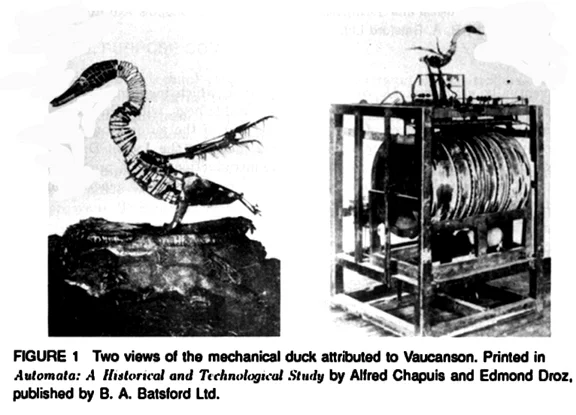In Aristotle's sense of the term, automaton means sheer random happening, and tyche refers to some cause and effect sequence outside the usual pattern of development. In more current usage, an automaton would be a bit of machinery exhibiting somewhat complex behavior but completely lacking in awareness. An automaton is a "self-moving" machine, and the development of control mechanisms led to the possibility of programming automata.
"People who experience themselves as automata, as robots, as bits of machinery, or even as animals...are rightly regarded as crazy. Yet why do we not regard a theory that seeks to transmute persons into automata or animals as equally crazy?" R.D. Laing, The Divided Self
"The automaton is the last step in a process that began with the use of one part or another of the human body as a tool," (Mumford) For Mumford, "Magic was the bridge that united fantasy with technology: the dream of power with the engines of fulfillment." (Technics, p. 40) "At every stage of technique...the ability of the artificer to produce a working simulacrum of a living organism has always intrigued people. This desire to produce and study automata has always been expressed in the living technique of the age. In the days of magic, we have the bizarre and sinister concept of the Golem, that figure of clay into which the rabbi of Prague breathed life with the blasphemy of the Ineffable Name of God. In the time of Newton, the automaton becomes the clockwork music box, with the little effigies priouetting stiffly on top. In the nineteenth century, the automaton is a glorified heat engine, burning some combustible fuel instead of the glycogen of the human muscles. Finally, the present automaton opens doors by means of photocells, (see intelligent building) or points guns to the place at which a radar beam picks up an airplane, or computes the solution of a differential equation." (Weiner, Cybernetics, pp39-40) see cyborg
In Mechanization Takes Command, Siegfried Gidion reviews the history of placing invention in service of the miraculous, from Hero of Alexandria to Jacques de Vaucanson's (1709-82) mechanical duck.
"Mechanistic theory has depended, historically, on the assumption that it is possible to construct an automaton, meaning a mechanism that is miraculous in and of itself and does not rely on human or animal muscle power." (Georges Canguilhem, Zone6)
For Descartes, self-preservation was the effect of the functioning of the organic automaton.
Although an automaton might consist, for example, of wires, transistors, relays and gears, the principles of its operation can be described in formal terms as a sequence of states and simple step-wise movements. Viewed abstractly, the automaton is a set of physically unspecified states, input, output, and operational rules. This specification is independent of what the actual components are made of. In the 1930's the work of logicians and mathematicians such as Turing, Church, Gödel, and Post contributed to the path-breaking exploration of themechanical computation processes and the insight that the essence of a mechanical process was not so much material-physical, but rather a program or control structure that could capture the process's functionality.
In a formal and mathematical vein, John von Neumann asked what kind of logical organization is sufficient for an automaton to reproduce itself. His efforts can be seen as an attempt to formalize the formation of life through a bio-logic. He first developed a "kinematic model" of a universal constructor and a description copier, which could produce copies of itself using a raw material as well as copies of the instructions for further use. Von Neumann was not entirely satisfied with this model, for it did not capture the minimal logical prerequisites for self-reproduction and did not specify how the constructor could recognize and assemble the raw materials. On the advice of the mathematician Stanislaw L. Ulam, he subsequently turned to models of cellular automata. (They are a class of polyautomata -- in which a multitude of interconnected automata acting in parallel form a larger automaton.)
